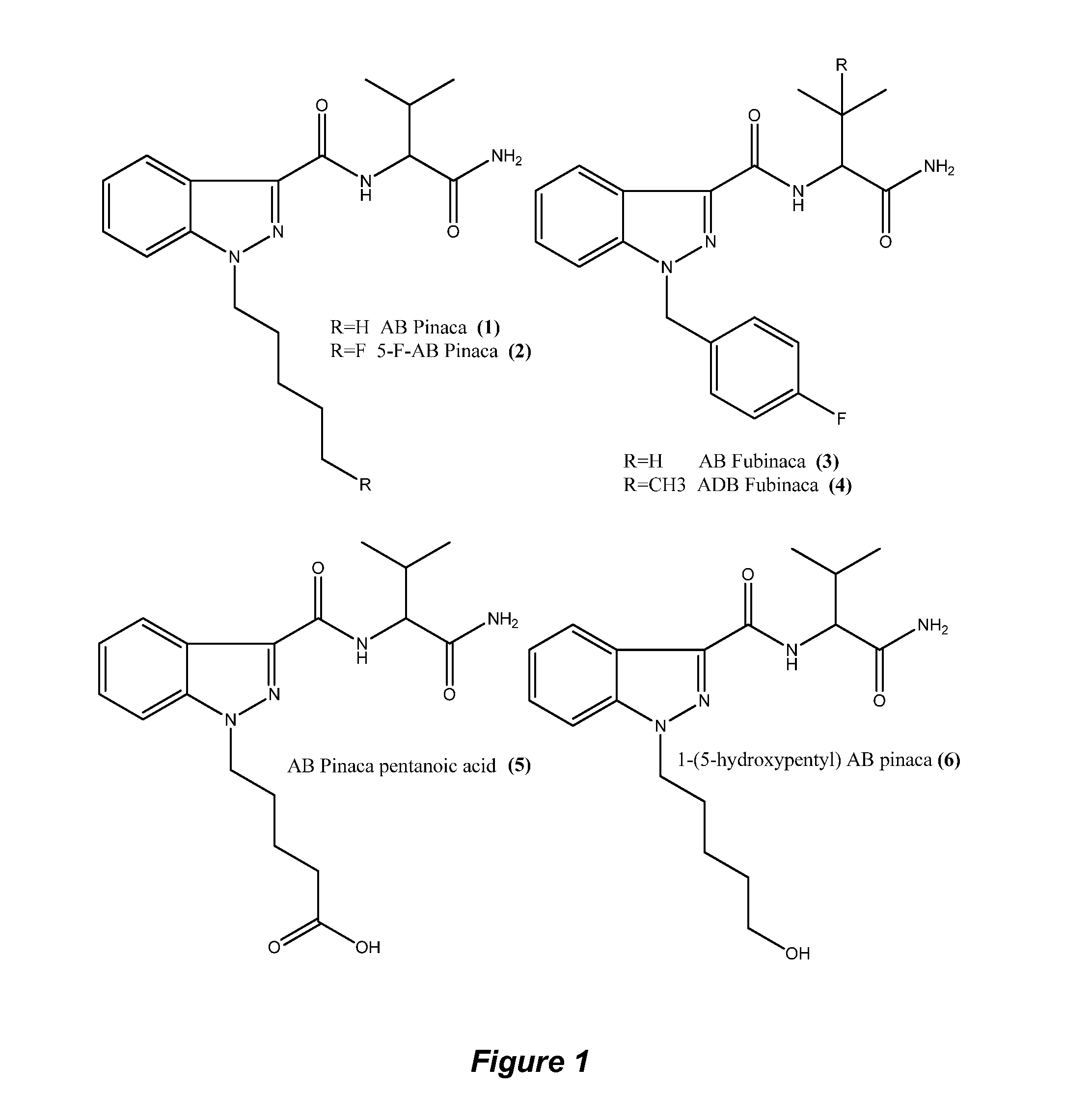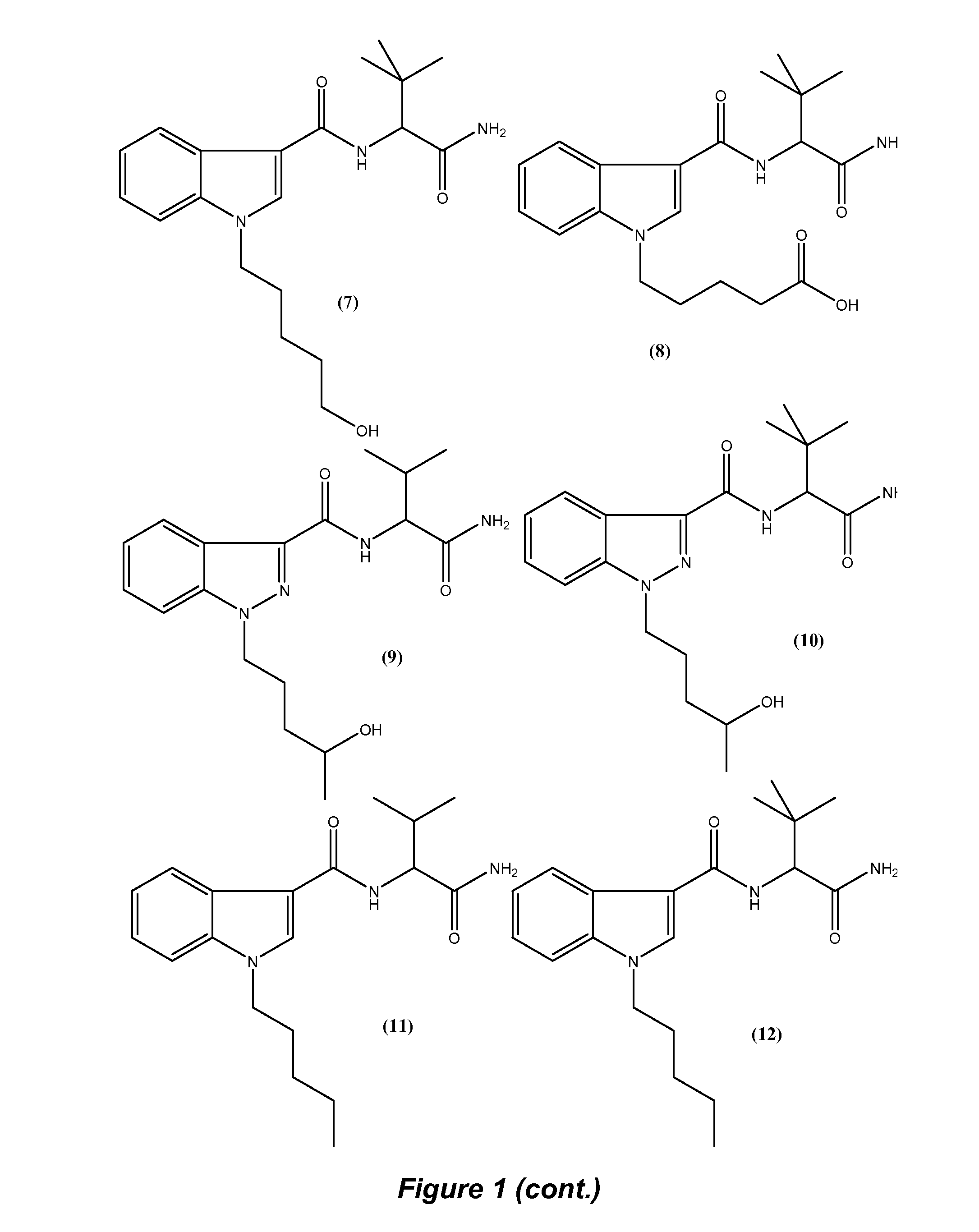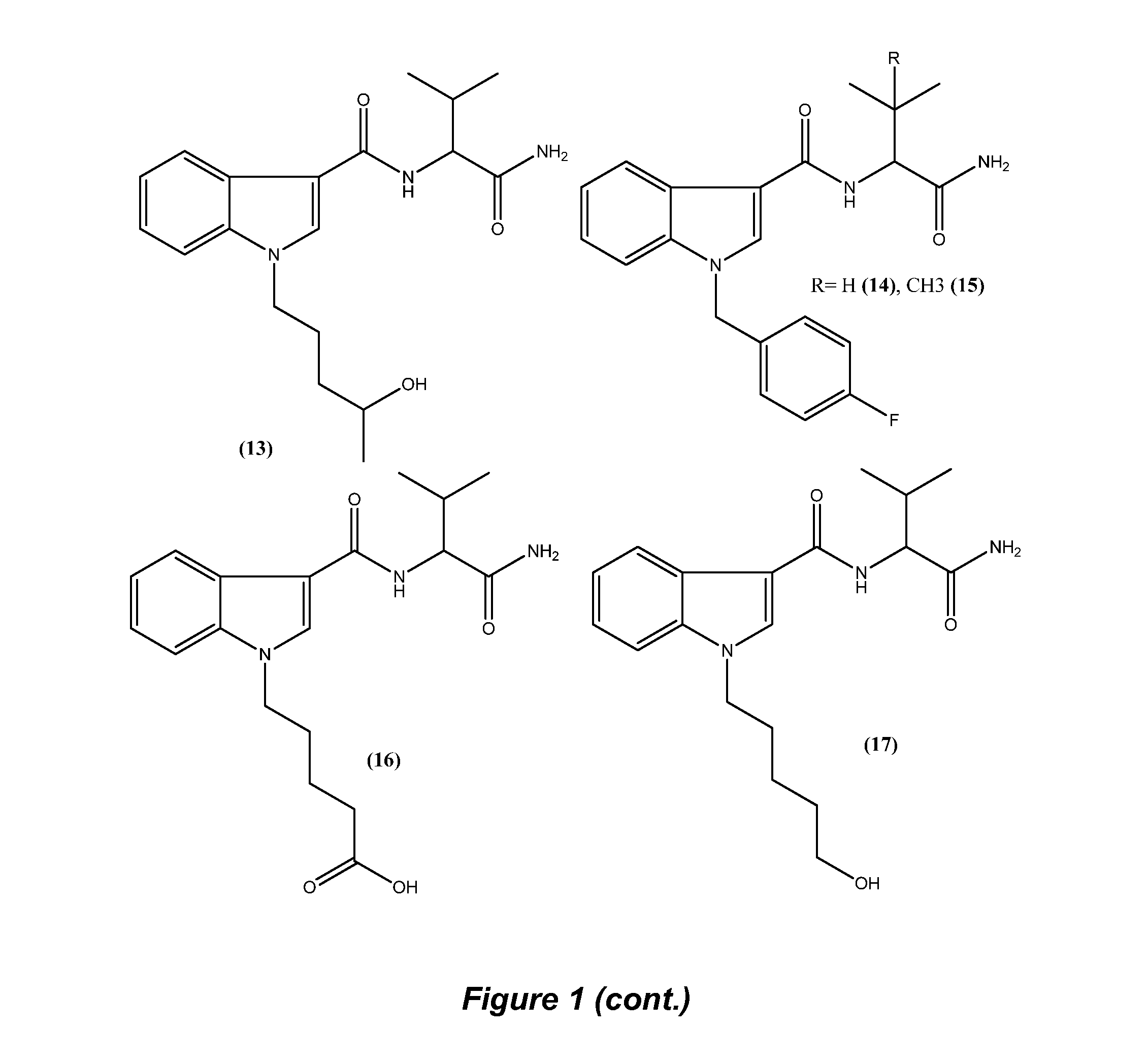Detection of indazole synthetic cannabinoids
a synthetic cannabinoid and indazole technology, applied in the field of detection of indazole synthetic cannabinoid, can solve the problems of time-consuming and labor-intensive detection of synthetic cannabinoid, and the detection of ms is time-consuming and labor-intensive, and requires expensive equipment and highly trained operators
- Summary
- Abstract
- Description
- Claims
- Application Information
AI Technical Summary
Benefits of technology
Problems solved by technology
Method used
Image
Examples
example 1
Synthesis of 1-(5-ethoxy-5-oxopentyl)-1H-indazole-3-carboxylic acid 2 (FIG. 2)
[0142]Indazole-3-carboxylic acid 1 (3.09 g, 19.1 mmol) was dissolved in DMF (80 ml) and the solution cooled to 0° C. Sodium hydride (3.9 g, 58.5 mmol) was then added portionwise and the mixture was heated to 60° C. for 30 minutes and then cooled to room temperature. Ethyl-5-bromovalerate (5 ml, 31.2 mmol) in DMF (10 mL) was added drop-wise and the mixture was stirred at 60° C. overnight. The mixture was cooled to room temperature and concentrated in vacuo. To the crude reside obtained was added water and ethyl acetate. The aqueous mixture was then acidified to pH 4 and extracted with ethyl acetate added (2×100 ml). The combined organic layers were dried over sodium sulphate, filtered and concentrated in vacuo. The crude residue was purified by column chromatography using chloroform as eluent to give 1-(5-ethoxy-5-oxopentyl)-1H-indazole-3-carboxylic acid 2 as a clear oil (2.43 g, 44%).
example 2
Synthesis of ethyl 5-[3-(1-amino-3-methyl-1-oxobutan-2-yl)carbamoyl)-1H-indazol-1-yl]pentanoate 3 (FIG. 2)
[0143]EDC.HCl (2.4 g, 12.5 mmol), L-valinimide HCl (1.94 g, 12.7 mmol), HOBt hydrate (1.96 g, 12.6 mmol) and DIPEA (7.2 ml, 42 mmol) were added to a solution of 1-(5-ethoxy-5-oxopentyl)-1H-indazole-3-carboxylic acid 2 (2.43 g, 8.4 mmol) in DMF (40 ml) and the mixture was stirred at room temperature overnight under nitrogen. The solvent was removed in vacuo and the crude residue dissolved in water (100 ml) and extracted with ethyl acetate (3×50 ml). The combined organic layers were washed by brine (10 0 ml), dried over sodium sulphate, filtered and concentrated in vacuo. The crude product obtained was purified by column chromatography using 10% MeOH / chloroform to give ethyl 5-[3-((1-amino-3-methyl-1-oxobutan-2-yl)carbamoyl)-1H-indazol-1-yl]pentanoate 3 (2.43 g, 75%) as yellow oil.
example 3
Synthesis of AB-Pinaca Pentanoic Acid 4 (Hapten-1) (FIG. 2)
[0144]A solution of potassium hydroxide (0.86 g) in water (2 5 ml) was added to a solution of ethyl 5-[3-((1-amino-3-methyl-1-oxobutan-2-yl) carbamoyl)-1H-indazol-1-yl]pentanoate 3 (2.43 g, 6.26 mmol) in THF (25 ml) and the solution was stirred at room temperature for 2 hours. The solvents were removed in vacuo and the remaining aqueous mixture was acidifed to pH 4-5. The aqueous layer was extracted with ethyl acetate (3×100 ml) and the combined organics layers were washed by brine (100 ml), dried over sodium sulphate and concentrated in vacuo to give crude product as a semisolid. The product was recrystallised from ethyl acetate / hexane and the white solid was filtered off and washed with diethyl ether to give AB-Pinaca pentanoic acid 4 (Hapten-1) (1.66 g, 74%). NMR 13C (DMSO d6): 174.26, 172.71, 161.37, 140.63, 136.46, 126.70, 122.54, 121.98, 121.68, 110.46, 56.86, 48.48, 33.09, 31.24, 28.91, 21.75, 19.39, 18.00.
PUM
| Property | Measurement | Unit |
|---|---|---|
| Fraction | aaaaa | aaaaa |
| Fraction | aaaaa | aaaaa |
| Fraction | aaaaa | aaaaa |
Abstract
Description
Claims
Application Information
 Login to View More
Login to View More - R&D
- Intellectual Property
- Life Sciences
- Materials
- Tech Scout
- Unparalleled Data Quality
- Higher Quality Content
- 60% Fewer Hallucinations
Browse by: Latest US Patents, China's latest patents, Technical Efficacy Thesaurus, Application Domain, Technology Topic, Popular Technical Reports.
© 2025 PatSnap. All rights reserved.Legal|Privacy policy|Modern Slavery Act Transparency Statement|Sitemap|About US| Contact US: help@patsnap.com



